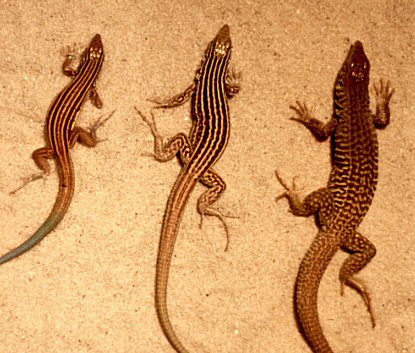- Cnemidophorus neomexicanus
Taxobox
name = New Mexico Whiptail
status = LC | status_system = IUCN3.1

image_caption = Three species of whiptail: Little Striped Whiptail, ("C. inornatus"), New Mexico Whiptail ("C. neomexicanus") and Tiger Whiptail ("C. tigris").
regnum =Animal ia
phylum = Chordata
classis = Reptilia
ordo =Squamata
subordo =Sauria
familia =Teiidae
genus = "Cnemidophorus "
species = "C. neomexicanus"
binomial = "Cnemidophorus neomexicanus"
binomial_authority = Lowe & Zweifel, 1952
synonyms = "Cnemidophorus perplexus"
Baird & Girard, 1852
"Aspidoscelis neomexicana"
Reeder, 2002The New Mexico Whiptail ("Cnemidophorus neomexicanus") is a
species oflizard found in the southernUnited States inNew Mexico andArizona , and in northernMexico inChihuahua . It is one of many lizard species known to be parthenogenic.Description
The New Mexico Whiptail grows from 6.5 to 9 inches in length, and is typically overall brown or black in color with seven pale yellow stripes from head to
tail . Light colored spots often occur between the stripes. They have a white or pale blue underside, with a blue or blue-green colored throat. They are slender bodied, with a long tail.Behavior
Like most other whiptail lizards, the New Mexico Whiptail is diurnal and insectivorous. They are wary, energetic, and fast moving, darting for cover if approached. They are found in a wide variety of semi-arid habitats, including
grassland , rocky areas, shrubland, or mountainside woodlands. Reproduction occurs throughparthenogenesis , with up to four unfertilized eggs being laid in mid summer, and hatching approximately eight weeks later.The New Mexico Whiptail Lizard is a crossbreed of a Western Whiptail which lives in the desert and the Little Striped Whiptail that favours grasslands. The lizard is a female-only species that reproduces by producing an egg that is a clone of itself.
References
*EMBL genus|genus=Cnemidophorus|species=neomexicanus
* [http://www.zo.utexas.edu/research/txherps/lizards/cnemidophorus.neomexicanus.html Herps of Texas: "Cnemidophorus neomexicanus"]
Wikimedia Foundation. 2010.
